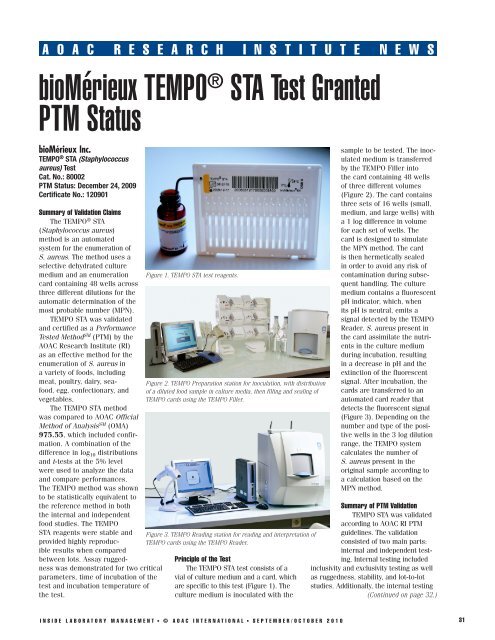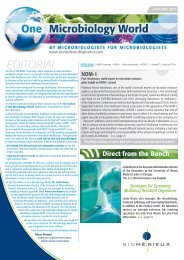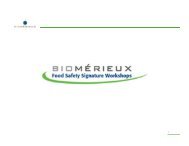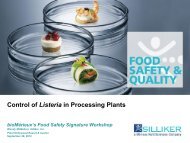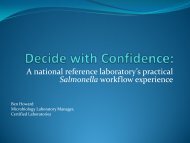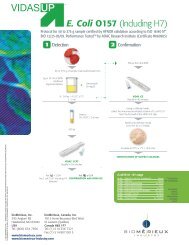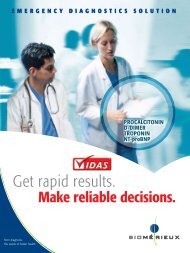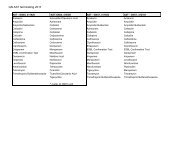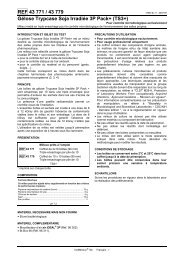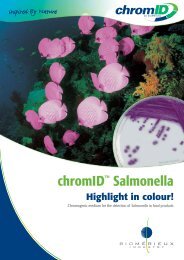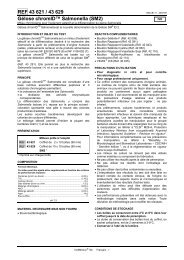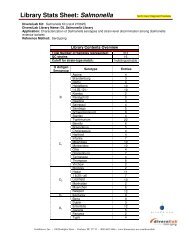TEMPO STA AOAC ILM article, Sept/Oct 2010 - bioMerieux
TEMPO STA AOAC ILM article, Sept/Oct 2010 - bioMerieux
TEMPO STA AOAC ILM article, Sept/Oct 2010 - bioMerieux
You also want an ePaper? Increase the reach of your titles
YUMPU automatically turns print PDFs into web optimized ePapers that Google loves.
A O A C R E S E A R C h I N S T I T u T E N E w S<br />
bioMérieux <strong>TEMPO</strong> ® <strong>STA</strong> Test Granted<br />
PTM Status<br />
bioMérieux Inc.<br />
<strong>TEMPO</strong> ® <strong>STA</strong> (Staphylococcus<br />
aureus) Test<br />
Cat. No.: 80002<br />
PTM Status: December 24, 2009<br />
Certificate No.: 120901<br />
Summary of Validation Claims<br />
The <strong>TEMPO</strong> ® <strong>STA</strong><br />
(Staphylococcus aureus)<br />
method is an automated<br />
system for the enumeration of<br />
S. aureus. The method uses a<br />
selective dehydrated culture<br />
medium and an enumeration<br />
card containing 48 wells across<br />
three different dilutions for the<br />
automatic determination of the<br />
most probable number (MPN).<br />
<strong>TEMPO</strong> <strong>STA</strong> was validated<br />
and certified as a Performance<br />
Tested Method SM (PTM) by the<br />
<strong>AOAC</strong> Research Institute (RI)<br />
as an effective method for the<br />
enumeration of S. aureus in<br />
a variety of foods, including<br />
meat, poultry, dairy, seafood,<br />
egg, confectionary, and<br />
vegetables.<br />
The <strong>TEMPO</strong> <strong>STA</strong> method<br />
was compared to <strong>AOAC</strong> Official<br />
Method of Analysis SM (OMA)<br />
975.55, which included confirmation.<br />
A combination of the<br />
difference in log 10 distributions<br />
and t-tests at the 5% level<br />
were used to analyze the data<br />
and compare performances.<br />
The <strong>TEMPO</strong> method was shown<br />
to be statistically equivalent to<br />
the reference method in both<br />
the internal and independent<br />
food studies. The <strong>TEMPO</strong><br />
<strong>STA</strong> reagents were stable and<br />
provided highly reproducible<br />
results when compared<br />
between lots. Assay ruggedness<br />
was demonstrated for two critical<br />
parameters, time of incubation of the<br />
test and incubation temperature of<br />
the test.<br />
Figure 1. <strong>TEMPO</strong> <strong>STA</strong> test reagents.<br />
Figure 2. <strong>TEMPO</strong> Preparation station for inoculation, with distribution<br />
of a diluted food sample in culture media, then filling and sealing of<br />
<strong>TEMPO</strong> cards using the <strong>TEMPO</strong> Filler.<br />
Figure 3. <strong>TEMPO</strong> Reading station for reading and interpretation of<br />
<strong>TEMPO</strong> cards using the <strong>TEMPO</strong> Reader.<br />
principle of the Test<br />
The <strong>TEMPO</strong> <strong>STA</strong> test consists of a<br />
vial of culture medium and a card, which<br />
are specific to this test (Figure 1). The<br />
culture medium is inoculated with the<br />
INSIDE LABORATORY MANAGEMENT ■ © <strong>AOAC</strong> INTERNATIONAL ■ SEpTEMBER/OCTOBER <strong>2010</strong><br />
sample to be tested. The inoculated<br />
medium is transferred<br />
by the <strong>TEMPO</strong> Filler into<br />
the card containing 48 wells<br />
of three different volumes<br />
(Figure 2). The card contains<br />
three sets of 16 wells (small,<br />
medium, and large wells) with<br />
a 1 log difference in volume<br />
for each set of wells. The<br />
card is designed to simulate<br />
the MPN method. The card<br />
is then hermetically sealed<br />
in order to avoid any risk of<br />
contamination during subsequent<br />
handling. The culture<br />
medium contains a fluorescent<br />
pH indicator, which, when<br />
its pH is neutral, emits a<br />
signal detected by the <strong>TEMPO</strong><br />
Reader. S. aureus present in<br />
the card assimilate the nutrients<br />
in the culture medium<br />
during incubation, resulting<br />
in a decrease in pH and the<br />
extinction of the fluorescent<br />
signal. After incubation, the<br />
cards are transferred to an<br />
automated card reader that<br />
detects the fluorescent signal<br />
(Figure 3). Depending on the<br />
number and type of the positive<br />
wells in the 3 log dilution<br />
range, the <strong>TEMPO</strong> system<br />
calculates the number of<br />
S. aureus present in the<br />
original sample according to<br />
a calculation based on the<br />
MPN method.<br />
Summary of pTM Validation<br />
<strong>TEMPO</strong> <strong>STA</strong> was validated<br />
according to <strong>AOAC</strong> RI PTM<br />
guidelines. The validation<br />
consisted of two main parts:<br />
internal and independent testing.<br />
Internal testing included<br />
inclusivity and exclusivity testing as well<br />
as ruggedness, stability, and lot-to-lot<br />
studies. Additionally, the internal testing<br />
(Continued on page 32.)<br />
31
32<br />
A O A C R E S E A R C h I N S T I T u T E N E w S<br />
bioMérieux TEMpO ® <strong>STA</strong> Test Granted pTM Status<br />
Continued from page 31.<br />
included method comparison studies for<br />
15 claimed matrixes: fresh ground beef<br />
patties, raw milk, filet of beef, cheddar<br />
cheese, prosciutto, vanilla ice cream,<br />
nonfat dry milk, cooked diced chicken,<br />
chicken salad, chocolate éclairs, tuna<br />
salad, frozen hash browns, smoked<br />
salmon, frozen mixed vegetables, and<br />
frozen egg omelets. Independent laboratory<br />
testing included method comparison<br />
studies for three claimed matrixes,<br />
including fresh ground beef, cooked diced<br />
chicken, and vanilla ice cream.<br />
Twenty test portions of each food<br />
matrix were analyzed by both methods<br />
and included five replicates of three<br />
different lots that were artificially contaminated<br />
at low, medium, and high<br />
levels with S. aureus and five uninoculated<br />
control samples for each food.<br />
A 1:10 dilution of each sample was<br />
prepared and stomached for 2 minutes.<br />
For each diluted and stomached<br />
sample, 1.0 mL of diluted food sample<br />
was added to a <strong>TEMPO</strong> medium vial<br />
that had been reconstituted with 3.0 mL<br />
sterile distilled water. The inoculated<br />
medium in the vial was then transferred<br />
and sealed into the <strong>STA</strong> card by the<br />
automated <strong>TEMPO</strong> filler. The inoculated<br />
cards were incubated for 24 to<br />
27 hours at 35 ± 1°C. Cards were read<br />
using the automated <strong>TEMPO</strong> reader.<br />
Standard method testing was performed<br />
as detailed in OMA 975.55.<br />
Figure 4. Regression analysis.<br />
TAblE 1. ObSErvED biAS bETwEEN ThE <strong>TEMPO</strong> <strong>STA</strong> AND rEfErENCE METhOD<br />
Results<br />
The bacterial counts for <strong>TEMPO</strong> and<br />
the reference method were transformed<br />
to log 10 and the bias and corresponding<br />
95% confidence interval of the bias<br />
were calculated. Regression analysis<br />
was also performed on the data set<br />
along with a t-test of the mean values<br />
for the <strong>TEMPO</strong> and the reference<br />
method. The bias, 95% confidence<br />
interval, and t-test results for the data<br />
set are detailed in Table 1.<br />
The overall percent agreement<br />
between the <strong>TEMPO</strong> <strong>STA</strong> and reference<br />
method was calculated by determining<br />
the number of data points that exhibited<br />
log differences of less than 1. The agreement<br />
within 1 log for this study was 98%.<br />
The mean log counts for the <strong>TEMPO</strong> <strong>STA</strong><br />
method on the entire data set were not<br />
significantly different from those of the<br />
reference method. Regression analysis of<br />
this data set is detailed in Figure 4. The<br />
two methods gave similar results with a<br />
correlation coefficient (R) 0.91, intercept<br />
–0.018, and slope 0.99. The analysis<br />
of bias yielded a confidence interval<br />
result that indicates that there is no bias<br />
between the <strong>TEMPO</strong> <strong>STA</strong> and the reference<br />
method for these study data.<br />
bias Confidence interval P value<br />
<strong>TEMPO</strong> <strong>STA</strong> vs reference –0.047 [–0.11; 0.01] 0.115<br />
Independent Laboratory<br />
The results of this independent<br />
evaluation demonstrate that the bio-<br />
Mérieux <strong>TEMPO</strong> <strong>STA</strong> method is a rapid,<br />
reliable method for the enumeration of<br />
S. aureus. The amount of time to results<br />
is 24 hours compared to 3 to 4 days for<br />
<strong>AOAC</strong> 975.55. The simple rehydration<br />
of the <strong>TEMPO</strong> <strong>STA</strong> medium and addition<br />
of sample and the elimination of serial<br />
dilutions and pour plating significantly<br />
reduced the sample analysis time. In<br />
addition, the automated feature of the<br />
<strong>TEMPO</strong> <strong>STA</strong> method eliminates the<br />
often problematic issue of subjectivity<br />
observed with plate count methods.<br />
Conclusions<br />
In the <strong>AOAC</strong> PTM validation study,<br />
<strong>TEMPO</strong> <strong>STA</strong> method performance was<br />
equivalent to the reference method<br />
evaluated. By eliminating media<br />
preparation, serial dilutions, manual<br />
counting, and visual interpretation of<br />
results, automation of the <strong>TEMPO</strong> <strong>STA</strong><br />
system provides reliable, rapid results<br />
and significant economic savings in<br />
labor and increased efficiency. ■<br />
—Ronald L. Johnson, John C. Mills,<br />
and Judith Colón-Reveles<br />
Contributing Writers<br />
ron.johnson@biomerieux.com<br />
john.mills@biomerieux.com<br />
judith.colon-reveles@biomerieux.com<br />
<strong>TEMPO</strong> ® <strong>STA</strong> (Staphylococcus aureus) Test and<br />
system are available worldwide. For more information,<br />
visit www.<strong>bioMerieux</strong>.com and select<br />
the country of interest or type in <strong>TEMPO</strong> at the<br />
search option.<br />
Mention of trade names or commercial products<br />
is for identification only and does not constitute<br />
preference over similar ones not mentioned.<br />
If you are interested in submitting an <strong>article</strong><br />
regarding a test kit that has been granted<br />
Performance Tested Method SM status, contact<br />
Zerlinde Johnson at zjohnson@aoac.org.<br />
INSIDE LABORATORY MANAGEMENT ■ © <strong>AOAC</strong> INTERNATIONAL ■ SEpTEMBER/OCTOBER <strong>2010</strong>


